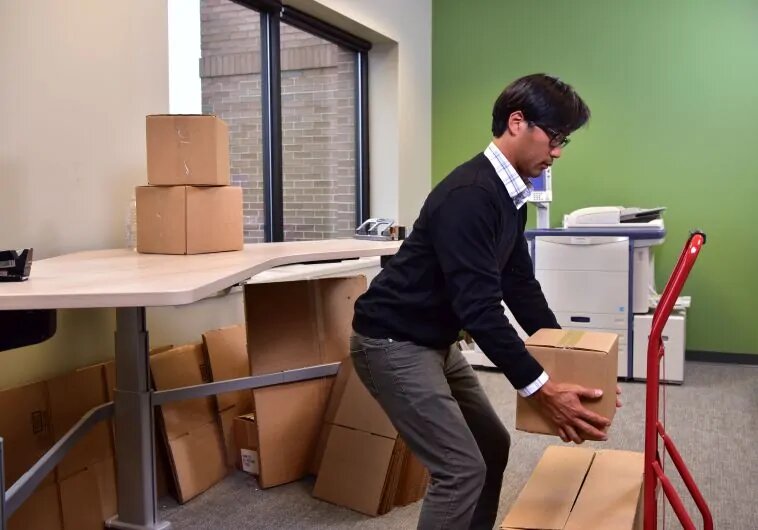A How-To Guide: The NIOSH Lifting Equation
Posted on March 17, 2020 | in Ergonomics

The National Institute of Occupational Safety and Health (NIOSH) has developed many useful tools and documents to aid industries in developing an ergonomics program. A commonly-used tool that NIOSH developed is the NIOSH Lifting Equation. The NIOSH Lifting Equation is used to determine the risk of a low back injury while performing lifting tasks. What many people do not know is when to properly use the NIOSH Lifting Equation, how to interpret the results, and how to develop solutions based on the information.
Why should I use the NIOSH Lifting Equation?
In the United States, more than one million back injuries occur in the workplace each year, contributing to more than 264 million workdays lost per year and $225.8 billion in direct and indirect costs to businesses each year .1
Low back pain and back injuries account for 38.5% of all work-related musculoskeletal disorders (MSDs) according to a 2016 report from the Bureau of Labor Statistics.2 MSDs affect the muscles, nerves, blood vessels, ligaments, and tendons, and if the roots of the problem are not addressed, MSDs continue to progress over time, leading to direct and indirect costs for the company.
NIOSH developed the Lifting Equation to help predict the risk of lifting injuries. The NIOSH Lifting Equation defines a Lifting Index (LI) based on the Recommended Weight Limit (RWL) for specific lifting tasks that most workers could perform in an eight-hour day without increasing the risk of developing low back pain MSDs.
When should I use the NIOSH Lifting Equation?
You can use the Lifting Equation to assess two-handed lifting and lowering tasks performed by one person standing.
However, you cannot use the Lifting Equation if the task is performed
- with one hand,
- for over 8 hours,
- while seated or kneeling,
- while pushing or pulling,
- with wheelbarrows or shovels,
- in a restricted workspace,
- with objects that are unstable (such as buckets or containers of liquids),
- with high-speed motion (faster than about 30 inches per second),
- with extremely hot or cold objects or in extreme temperatures, or
- with poor foot-to-floor coupling (high risk of a slip or fall).
How do I calculate the NIOSH Lifting Equation?
The NIOSH Lifting Equation defines a Recommended Weight Limit (RWL), a recommendation of the heaviest load a healthy worker could lift without increasing the risk of developing low back pain.
To determine the RWL, we need to find six critical measurements of the lifting task:
- Horizontal distance (distance of hands on the load from midpoint between ankles, H)
- Starting height of the hands from the ground (vertical location, V)
- Vertical travel distance of the lift (D)
- Time between lifts or frequency of lifting (F)
- Angle of the load in relation to the body (A)
- Quality of the grasp or handhold based on the type of handles available (coupling, C)
…where load constant (LC, weight of the object lifted) and other factors in the equation are as follows:
- HM, the Horizontal Multiplier factor
- VM, the Vertical Multiplier factor
- DM, the Distance Multiplier factor
- FM, the Frequency Multiplier factor
- AM, the Asymmetric Multiplier factor
- CM, the Coupling Multiplier factor
RWL = LC x HM x VM x DM x FM x AM x CM
The data for the factors are available on this website (government of Canada) and in this publication (government of USA), page 51.
Calculating the RWL using this formula helps you determine which of the six components of the task contribute most to the risk. The multiplier factors have a value between 0 and 1. The lower the multiplier, the higher the risk, and therefore the lower the RWL to prevent injuries.
Once you calculate the RWL, you can figure out the Lifting Index (LI) to provide a relative estimate of the physical stress associated with a manual lifting job. A LI over 1.5 indicates an increased level of stress, and therefore an increased risk of injury (Fox et al., 2019). As the LI increases, the percentage of workers who can safely perform the task decreases.
LI = Load weight/RWL

How do I develop solutions based on results from the NIOSH Lifting Equation?
In addition to seeing and understanding which factor in the lifting task has the greatest risk, the equation allows you to test several scenarios in order to find the optimal lifting conditions. By varying the values in the formula according to your improvement ideas, you can anticipate the effects of the work modification before implementing it. Being able to modify the causal factors in the formula makes it possible to more quickly tackle the main factors contributing to increased injury risk.
The LI can also help you classify and prioritize workstations for improvement by developing a control strategy according to the prioritization order based on the LI (the jobs with the highest LI should have higher priority for improvement).
Get help calculating the NIOSH Lifting Equation
This equation can seem very complicated and cumbersome to use, but NIOSH has developed a mobile app available for free on Google Play and App Store to help you calculate the RWL and LI.3
VelocityEHS has also published the following resources which you may find helpful:
- Ergo U: NIOSH: Guidelines for Safe Manual Material Handling
- Using the Hierarchy of Controls to Maximize MSD Risk Reduction
- Manual Material Handling Calculators
Sources
1 https://www.thegoodbody.com/back-injury-statistics/
2 https://www.bls.gov/opub/ted/2018/back-injuries-prominent-in-work-related-musculoskeletal-disorder-cases-in-2016.htm?view_full
3 https://www.cdc.gov/niosh/topics/ergonomics/nlecalc.html
Fox, Robert R., et al. “Understanding Outcome Metrics of Revised NIOSH Lifting Equation.” Applied Ergonomics, vol. 81, 2019, p.102897